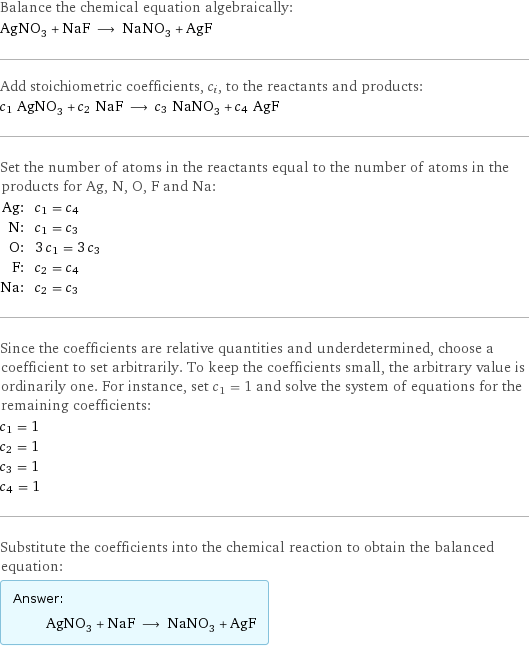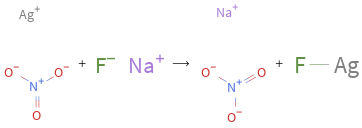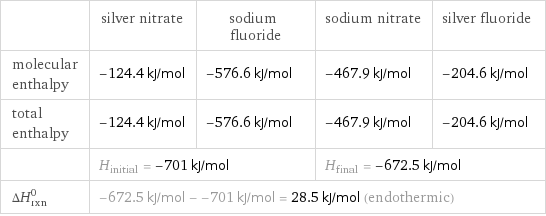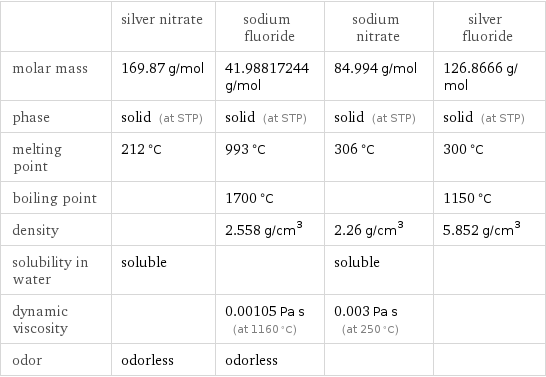Input interpretation

AgNO_3 silver nitrate + NaF sodium fluoride ⟶ NaNO_3 sodium nitrate + AgF silver fluoride
Balanced equation

Balance the chemical equation algebraically: AgNO_3 + NaF ⟶ NaNO_3 + AgF Add stoichiometric coefficients, c_i, to the reactants and products: c_1 AgNO_3 + c_2 NaF ⟶ c_3 NaNO_3 + c_4 AgF Set the number of atoms in the reactants equal to the number of atoms in the products for Ag, N, O, F and Na: Ag: | c_1 = c_4 N: | c_1 = c_3 O: | 3 c_1 = 3 c_3 F: | c_2 = c_4 Na: | c_2 = c_3 Since the coefficients are relative quantities and underdetermined, choose a coefficient to set arbitrarily. To keep the coefficients small, the arbitrary value is ordinarily one. For instance, set c_1 = 1 and solve the system of equations for the remaining coefficients: c_1 = 1 c_2 = 1 c_3 = 1 c_4 = 1 Substitute the coefficients into the chemical reaction to obtain the balanced equation: Answer: | | AgNO_3 + NaF ⟶ NaNO_3 + AgF
Structures

+ ⟶ +
Names

silver nitrate + sodium fluoride ⟶ sodium nitrate + silver fluoride
Reaction thermodynamics
Enthalpy

| silver nitrate | sodium fluoride | sodium nitrate | silver fluoride molecular enthalpy | -124.4 kJ/mol | -576.6 kJ/mol | -467.9 kJ/mol | -204.6 kJ/mol total enthalpy | -124.4 kJ/mol | -576.6 kJ/mol | -467.9 kJ/mol | -204.6 kJ/mol | H_initial = -701 kJ/mol | | H_final = -672.5 kJ/mol | ΔH_rxn^0 | -672.5 kJ/mol - -701 kJ/mol = 28.5 kJ/mol (endothermic) | | |
Equilibrium constant
![Construct the equilibrium constant, K, expression for: AgNO_3 + NaF ⟶ NaNO_3 + AgF Plan: • Balance the chemical equation. • Determine the stoichiometric numbers. • Assemble the activity expression for each chemical species. • Use the activity expressions to build the equilibrium constant expression. Write the balanced chemical equation: AgNO_3 + NaF ⟶ NaNO_3 + AgF Assign stoichiometric numbers, ν_i, using the stoichiometric coefficients, c_i, from the balanced chemical equation in the following manner: ν_i = -c_i for reactants and ν_i = c_i for products: chemical species | c_i | ν_i AgNO_3 | 1 | -1 NaF | 1 | -1 NaNO_3 | 1 | 1 AgF | 1 | 1 Assemble the activity expressions accounting for the state of matter and ν_i: chemical species | c_i | ν_i | activity expression AgNO_3 | 1 | -1 | ([AgNO3])^(-1) NaF | 1 | -1 | ([NaF])^(-1) NaNO_3 | 1 | 1 | [NaNO3] AgF | 1 | 1 | [AgF] The equilibrium constant symbol in the concentration basis is: K_c Mulitply the activity expressions to arrive at the K_c expression: Answer: | | K_c = ([AgNO3])^(-1) ([NaF])^(-1) [NaNO3] [AgF] = ([NaNO3] [AgF])/([AgNO3] [NaF])](../image_source/d7744f941602c650def4ebf8e1363e16.png)
Construct the equilibrium constant, K, expression for: AgNO_3 + NaF ⟶ NaNO_3 + AgF Plan: • Balance the chemical equation. • Determine the stoichiometric numbers. • Assemble the activity expression for each chemical species. • Use the activity expressions to build the equilibrium constant expression. Write the balanced chemical equation: AgNO_3 + NaF ⟶ NaNO_3 + AgF Assign stoichiometric numbers, ν_i, using the stoichiometric coefficients, c_i, from the balanced chemical equation in the following manner: ν_i = -c_i for reactants and ν_i = c_i for products: chemical species | c_i | ν_i AgNO_3 | 1 | -1 NaF | 1 | -1 NaNO_3 | 1 | 1 AgF | 1 | 1 Assemble the activity expressions accounting for the state of matter and ν_i: chemical species | c_i | ν_i | activity expression AgNO_3 | 1 | -1 | ([AgNO3])^(-1) NaF | 1 | -1 | ([NaF])^(-1) NaNO_3 | 1 | 1 | [NaNO3] AgF | 1 | 1 | [AgF] The equilibrium constant symbol in the concentration basis is: K_c Mulitply the activity expressions to arrive at the K_c expression: Answer: | | K_c = ([AgNO3])^(-1) ([NaF])^(-1) [NaNO3] [AgF] = ([NaNO3] [AgF])/([AgNO3] [NaF])
Rate of reaction
![Construct the rate of reaction expression for: AgNO_3 + NaF ⟶ NaNO_3 + AgF Plan: • Balance the chemical equation. • Determine the stoichiometric numbers. • Assemble the rate term for each chemical species. • Write the rate of reaction expression. Write the balanced chemical equation: AgNO_3 + NaF ⟶ NaNO_3 + AgF Assign stoichiometric numbers, ν_i, using the stoichiometric coefficients, c_i, from the balanced chemical equation in the following manner: ν_i = -c_i for reactants and ν_i = c_i for products: chemical species | c_i | ν_i AgNO_3 | 1 | -1 NaF | 1 | -1 NaNO_3 | 1 | 1 AgF | 1 | 1 The rate term for each chemical species, B_i, is 1/ν_i(Δ[B_i])/(Δt) where [B_i] is the amount concentration and t is time: chemical species | c_i | ν_i | rate term AgNO_3 | 1 | -1 | -(Δ[AgNO3])/(Δt) NaF | 1 | -1 | -(Δ[NaF])/(Δt) NaNO_3 | 1 | 1 | (Δ[NaNO3])/(Δt) AgF | 1 | 1 | (Δ[AgF])/(Δt) (for infinitesimal rate of change, replace Δ with d) Set the rate terms equal to each other to arrive at the rate expression: Answer: | | rate = -(Δ[AgNO3])/(Δt) = -(Δ[NaF])/(Δt) = (Δ[NaNO3])/(Δt) = (Δ[AgF])/(Δt) (assuming constant volume and no accumulation of intermediates or side products)](../image_source/ff61e15553a77a2b8a63eff9825b2667.png)
Construct the rate of reaction expression for: AgNO_3 + NaF ⟶ NaNO_3 + AgF Plan: • Balance the chemical equation. • Determine the stoichiometric numbers. • Assemble the rate term for each chemical species. • Write the rate of reaction expression. Write the balanced chemical equation: AgNO_3 + NaF ⟶ NaNO_3 + AgF Assign stoichiometric numbers, ν_i, using the stoichiometric coefficients, c_i, from the balanced chemical equation in the following manner: ν_i = -c_i for reactants and ν_i = c_i for products: chemical species | c_i | ν_i AgNO_3 | 1 | -1 NaF | 1 | -1 NaNO_3 | 1 | 1 AgF | 1 | 1 The rate term for each chemical species, B_i, is 1/ν_i(Δ[B_i])/(Δt) where [B_i] is the amount concentration and t is time: chemical species | c_i | ν_i | rate term AgNO_3 | 1 | -1 | -(Δ[AgNO3])/(Δt) NaF | 1 | -1 | -(Δ[NaF])/(Δt) NaNO_3 | 1 | 1 | (Δ[NaNO3])/(Δt) AgF | 1 | 1 | (Δ[AgF])/(Δt) (for infinitesimal rate of change, replace Δ with d) Set the rate terms equal to each other to arrive at the rate expression: Answer: | | rate = -(Δ[AgNO3])/(Δt) = -(Δ[NaF])/(Δt) = (Δ[NaNO3])/(Δt) = (Δ[AgF])/(Δt) (assuming constant volume and no accumulation of intermediates or side products)
Chemical names and formulas

| silver nitrate | sodium fluoride | sodium nitrate | silver fluoride formula | AgNO_3 | NaF | NaNO_3 | AgF Hill formula | AgNO_3 | FNa | NNaO_3 | AgF name | silver nitrate | sodium fluoride | sodium nitrate | silver fluoride IUPAC name | silver nitrate | sodium fluoride | sodium nitrate | fluorosilver
Substance properties

| silver nitrate | sodium fluoride | sodium nitrate | silver fluoride molar mass | 169.87 g/mol | 41.98817244 g/mol | 84.994 g/mol | 126.8666 g/mol phase | solid (at STP) | solid (at STP) | solid (at STP) | solid (at STP) melting point | 212 °C | 993 °C | 306 °C | 300 °C boiling point | | 1700 °C | | 1150 °C density | | 2.558 g/cm^3 | 2.26 g/cm^3 | 5.852 g/cm^3 solubility in water | soluble | | soluble | dynamic viscosity | | 0.00105 Pa s (at 1160 °C) | 0.003 Pa s (at 250 °C) | odor | odorless | odorless | |
Units
